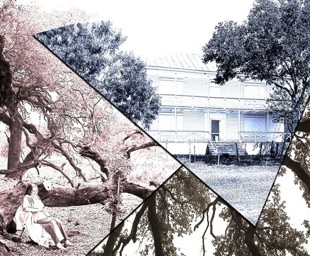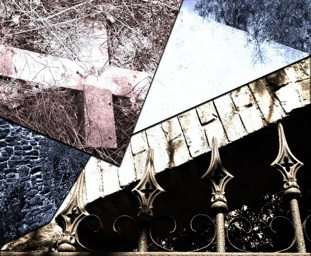Historic District
Mexico won independence from Spain in 1821, and immigrants began arriving in San Antonio de Bexar. By accepting Mexican citizenship and professing to be Catholic, U.S. immigrant settlers were allowed to possess property. The beginning of this period was marked by Anglo-American loyalty to Mexico, but in time these settlers completely disengaged their allegiances to Mexico and switched to Anglo-American identification, dominance and empathy toward the United States.
During Texas’ battle for independence, Jose Ignacio Pérez, owner of the Rancho de la Purisima Concepcion on the Media River, left his property (now Land Heritage Institute) to relocate his family to the Rio Grande river area for the duration of the revolution, leaving his property in the care of friends. Upon his return to the new Republic of Texas in 1846, he discovered that squatters had laid claim to 16,000 acres on the south bank of the Medina River that had once made up part of his 24,000 acre ranch.
To fund its fledgling government, the Republic of Texas turned to the sale of land in the public domain. Many of these new “head” or land grants overlapped earlier Spanish and Mexican land grants, including those of the Pérez family. Of seventeen land grants involving the LHI property, only four remained in the hands of Mexican families and their descendants.
During the early- and mid-1800s, the LHI property was parceled and sold to early Texas settler families including the Applewhites, the Presnalls and the Watsons. These families and their descendants worked the land, some which included the LHI property, until the land was claimed by eminent domain by the City of San Antonio for the Applewhite Reservoir Project in the early 1980s.
In the 1990s, when the Applewhite Reservoir was voted down by San Antonio citizens, the land was put in trust to the Land Heritage Institute to preserve and protect its rich natural and cultural resources. Today many descendants of the original homesteading families are working together with Land Heritage Institute to keep the property intact for future Texas generations to enjoy.


Cattle Ranchers
The Texas cattle-ranching tradition originated in the 1700’s--it developed out of the capturing of wild stock left behind by 16th- and 17th-century Spanish explorers. Cattle ranching was initially dominated by the Spanish missions. However the American Revolution in 1776 stimulated the ranching economy of the region when cattle were driven to Louisiana to feed the troops. This marked the decline of mission-based ranching and the emergence of private ranches. Ignacio de Perez, original owner of the LHI property, created a Spanish style rancho with vaquero’s that managed the native cattle know as “Longhorns.”
The Bexar-Bahia area is regarded as the cradle of Texas ranching where major techniques for stock handling, branding and cattle raising, along with cowboy accessories such as chaps, saddles, lariats, and other ranching equipment were developed. Trail drives moved the cattle to market; the cattle industry saw the emergence of important ranching families which resulted in cattle dynasties providing support and control of communities in the area.
The Presnall and Watson families ranched the property from 1882 to 1991; part of the history of the Chisholm and Great Western Trails starts with this farmstead. This land was one of the many gathering points for Longhorn cattle being driven across the Medina River at the Applewhite Crossing on the immediate west boundary of the Land Heritage Institute property marking the beginnings of the Great Western and Chisholm Trails. While railroads and refrigeration have changed some aspects of cattle marketing, much of the herding and stock handling traditions have continued to the present day.
Land Heritage Institute has re-established a herd of Longhorn Cattle on the site providing visitors an opportunity to view the cattle at close range. These purebred Longhorns are registered with the Cattlemen’s Texas Longhorn Registry (CTLR), an organization dedicated to the preservation of the authentic Longhorn bloodline.

The Marqués de Croix reported to King Carlos of Spain that only through the settlement of families in this volatile new territory of Nueva España would Spain’s hold on the land be ensured. In March of 1731, José Antonio Peres de Casanova arrived in San Antonio as part of an immigration expedition representing sixteen families from the Spanish Canary Islands.
Many early settlers failed to withstand the remote area and the destructive repercussions associated with the indigenous Lipan Apaches and Comanches. Jose Peres persevered, and on the land between the Leon and Medina Rivers he built his home and raised his family. He married Paula Granado with whom he had eight children. Cattle raising was the primary source of income for the Peres family. Although the land had been legally claimed by Mission San José, it was agreed that Jose Antonio Peres de Casanova’s entrepreneurial cattle-ranching skills benefitted the mission community so he was permitted to continue to practice and reside there with his family.
Under Juan Ignacio Pérez, the grandson of Jose Peres born in 1761, the Pérez cattle ranching dynasty flourished. Jose inherited his grandfather’s love for the land and the cattle. His focus was to extend the Pérez family ranch; he became a true frontiersman.
In 1908 the Pérez family was given a land grant of approximately 12 statute miles west of the Medina to graze their stock. The Pérez family’s rancho now included more than 20,000 acres. It is still known as “the oldest family-owned ranch in Texas.”
Remnants of the house and chapel built by the Pérez family exist today on property adjacent to the Land Heritage Institute--acreage which was worked by the Pérez family and their descendants until the 1990's.


Agriculture involving livestock and crops has been the primary occupation by which Native-Americans, European-Americans and African-Americans supported their families along the middle Medina River and elsewhere in rural Bexar County for most of the historic period predating World War II.
Immigration to the area by southeasterners, along with their slaves, increased greatly in the 1840’s and early 1850’s. It was during this time that the Applewhite and the Presnall families arrived in Texas. With their slaves, they continued the plantation-style farming they had practiced in the past. The cultivation of cotton and other crops, as well as cattleraising and the keeping of slaves, became integral parts of their ranching and family life on what is now the Land Heritage Institute property.
Slavery was also practiced on the Perez family rancho from the early 1800’s until the Civil War. Concepcion Linn, daughter of Maria Josefa Perez, depended heavily on a slave named Henry Burl Ross who lived on their ranch. His grandmother had been a slave that was leased to the Linn family and he came with her to the property. Burl, or Uncle Burr as he was known, worked on the ranch for 86 years--both as a slave and as a free man.
African-Americans contributed to the building and cultivation of the south Texas region and continued working the land as sharecroppers after the Civil War. Descendants of the slaves who helped build the farms and ranches that constitute the Land Heritage Institute property still live in the south Texas region.
Though the history of these slaves is not well documented, their contribution of hard labor made the difficult life on this land unquestionably easier for the Anglo-American property-owner/slave-holder families.